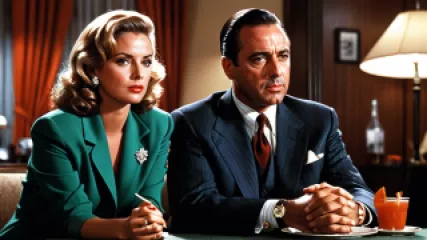Lessons on Adult Attachment from Classic Films
Lessons on Adult Attachment from Classic Films
Understanding attachment styles in adults is a critical aspect of cultivating healthy and fulfilling relationships. While we may not often think to look to the silver screen for insights on such a profound topic, classic films can actually provide a wealth of wisdom when it comes to the complex dynamics of adult attachment. By carefully examining the relationships depicted in some of cinema's most beloved stories, we can glean valuable lessons that can be applied to our own lives and connections.
In this article, we'll dive into several iconic films and explore how the attachment styles of the central characters can inform our own understanding of how we form bonds, manage conflict, and find lasting intimacy as adults. From the tumultuous love affair in Casablanca to the familial dynamics at play in The Godfather, we'll unpack the nuances of attachment theory and consider how these timeless tales can help us navigate the sometimes-murky waters of adult relationships.
Attachment Styles 101
Before we delve into the cinematic case studies, it's important to establish a basic understanding of attachment theory and the various styles that can manifest in adulthood. Developed by psychologist John Bowlby in the 1950s, attachment theory posits that the way we bond with our primary caregivers in childhood lays the foundation for how we approach relationships throughout our lives.
There are four primary attachment styles that have been identified by researchers:
- Secure attachment: Individuals with a secure attachment style tend to feel comfortable with intimacy, are able to rely on others, and have a positive view of both themselves and their relationships.
- Anxious attachment: Those with an anxious attachment style often experience heightened levels of worry and insecurity in their relationships, seeking constant reassurance and validation from their partners.
- Avoidant attachment: Individuals with an avoidant attachment style tend to be uncomfortable with closeness, preferring to maintain emotional distance and independence in their relationships.
- Disorganized attachment: This attachment style is characterized by a lack of a consistent strategy for dealing with attachment-related distress, leading to unpredictable and chaotic relationship dynamics.
These attachment styles can have a profound impact on how we navigate the complexities of adult relationships, from how we communicate our needs to how we handle conflict and intimacy. By understanding our own attachment tendencies, as well as those of our partners, we can develop more self-awareness and the tools to build healthier, more fulfilling connections.
Casablanca: A Bittersweet Reunion
Few films have captured the bittersweet complexities of love and loss quite like the classic Casablanca. At the heart of this timeless tale is the relationship between Rick Blaine (Humphrey Bogart) and Ilsa Lund (Ingrid Bergman), two former lovers whose passionate affair was cut short by the chaos of World War II.
From the outset, it's clear that Rick and Ilsa share a deep, secure attachment – they are comfortable with intimacy, trust each other implicitly, and have a positive view of their relationship. However, the unexpected reappearance of Ilsa's husband, Victor Laszlo (Paul Henreid), throws a wrench into their plans and forces them to confront the unresolved issues of their past.
"We'll always have Paris," Rick tells Ilsa, a bittersweet acknowledgment of the profound connection they once shared. Casablanca (1942)
Ilsa's anxious attachment style becomes evident as she grapples with the conflicting loyalties of her heart and her sense of duty to her husband. Her constant need for reassurance and validation from Rick mirrors the insecurity and heightened emotionality that often characterize the anxious attachment style.
Meanwhile, Rick's avoidant attachment tendencies emerge as he struggles to come to terms with Ilsa's decision to leave him. His initial emotional distance and reluctance to fully engage with Ilsa are classic hallmarks of the avoidant attachment profile.
Ultimately, the tragic ending of Casablanca serves as a poignant reminder that even the strongest bonds can be tested by the demands of the outside world. Rick and Ilsa's bittersweet farewell, while heartbreaking, also reflects the resilience and adaptability that can emerge from navigating the challenges of adult attachment.
The Godfather: Toxic Family Ties
Whereas Casablanca explored the complexities of romantic attachment, Francis Ford Coppola's seminal crime drama The Godfather delves into the equally fraught dynamics of family relationships. At the heart of this epic saga lies the Corleone clan, a powerful organized crime family whose members grapple with a range of attachment styles that shape their choices and destinies.
The patriarch of the Corleone family, Vito Corleone (Marlon Brando), embodies a secure attachment style in his relationships with his children. He is emotionally available, nurturing, and provides a strong sense of safety and stability – qualities that help to foster the loyalty and devotion of his offspring.
However, Vito's youngest son, Michael (Al Pacino), exhibits a more anxious attachment style as he navigates the treacherous world of his family's criminal empire. Michael's constant need for approval and validation from his father, as well as his tendency to resort to violence to protect his loved ones, reflect the insecurity and heightened emotional reactivity that are hallmarks of the anxious attachment profile.
"I'm gonna make him an offer he can't refuse," Michael Corleone famously declares, underscoring the ruthless lengths he's willing to go to in order to maintain control and ensure the family's survival. The Godfather (1972)
In contrast, Michael's older brother, Sonny (James Caan), displays a more disorganized attachment style. Prone to unpredictable outbursts of violence and an inability to regulate his emotions, Sonny's chaotic relationships and ultimate demise reflect the tumultuous and unstable nature of the disorganized attachment profile.
Through the lens of attachment theory, the Corleone family's saga serves as a cautionary tale about the consequences of unresolved attachment issues. The inability of the family members to healthily process their emotions and form secure bonds ultimately leads to a downward spiral of betrayal, violence, and tragedy.
When Harry Met Sally: The Friendship-to-Love Transition
While the previous examples explored the darker side of attachment dynamics, Rob Reiner's romantic comedy When Harry Met Sally offers a more lighthearted – yet no less insightful – exploration of how attachment styles can shape the trajectory of a relationship.
The film follows the decades-long friendship between Harry Burns (Billy Crystal) and Sally Albright (Meg Ryan), two acquaintances who initially clash due to their contrasting attachment styles. Sally, with her secure attachment style, is comfortable with intimacy and able to form deep, trusting bonds. Harry, on the other hand, exhibits an avoidant attachment style, preferring to maintain emotional distance and independence in his relationships.
Over the course of their encounters, we witness the gradual evolution of Harry and Sally's dynamic, as they navigate the delicate balance between friendship and romantic attraction. Harry's avoidant tendencies create obstacles, as he struggles to fully commit to Sally and open himself up to the vulnerability of a romantic partnership.
"I came here tonight because when you realize you want to spend the rest of your life with somebody, you want the rest of your life to start as soon as possible," Harry confesses to Sally, finally overcoming his attachment-driven fears. When Harry Met Sally (1989)
Meanwhile, Sally's secure attachment style provides a steadying influence, as she patiently supports Harry's emotional growth and helps him to confront his own attachment-related insecurities.
Ultimately, the film's triumphant conclusion, in which Harry and Sally overcome their differences and commit to a lasting romantic partnership, serves as a heartwarming testament to the power of attachment styles to evolve and adapt over time. Their journey reminds us that even the most deeply ingrained attachment patterns can be challenged and transformed through mutual understanding, empathy, and the willingness to take emotional risks.
Exploring Attachment Styles in Your Own Life
While the characters and relationships depicted in these classic films may seem worlds apart from our own lived experiences, the insights they offer about adult attachment styles can be invaluable tools for personal growth and relationship-building.
By carefully examining the attachment-related dynamics at play in these iconic stories, we can gain a deeper understanding of our own tendencies and patterns when it comes to forming and maintaining connections with others. Are we, like Rick Blaine, prone to emotional avoidance in the face of conflict? Do we, akin to Michael Corleone, struggle with an anxious need for validation and control? Or perhaps we, similar to Sally Albright, possess a secure attachment style that allows us to navigate the ups and downs of relationships with resilience and grace.
Regardless of our starting point, the lessons we can glean from these cinematic case studies can empower us to cultivate more fulfilling and healthy adult attachments. By becoming more self-aware of our attachment styles, we can work to address any underlying insecurities or avoidant tendencies, and develop the skills necessary to forge deeper, more meaningful connections.
Conclusion: The Power of Attachment in Our Lives
In the end, the profound insights we can gain about adult attachment from classic films serve as a poignant reminder that the bonds we form – or fail to form – can have a profound impact on the trajectory of our lives. Whether we find ourselves emulating the tragic romance of Rick and Ilsa, the toxic family dynamics of the Corleones, or the ultimate triumph of Harry and Sally, understanding the role of attachment in our relationships can unlock a world of personal growth, empowerment, and the possibility of lasting, fulfilling connections.
So the next time you find yourself lost in the timeless magic of the silver screen, pay close attention to the ways in which the characters navigate the complexities of love, family, and friendship. For within those flickering images, you just might uncover the key to unlocking your own attachment-related insights and finding the path to your happily ever after.






